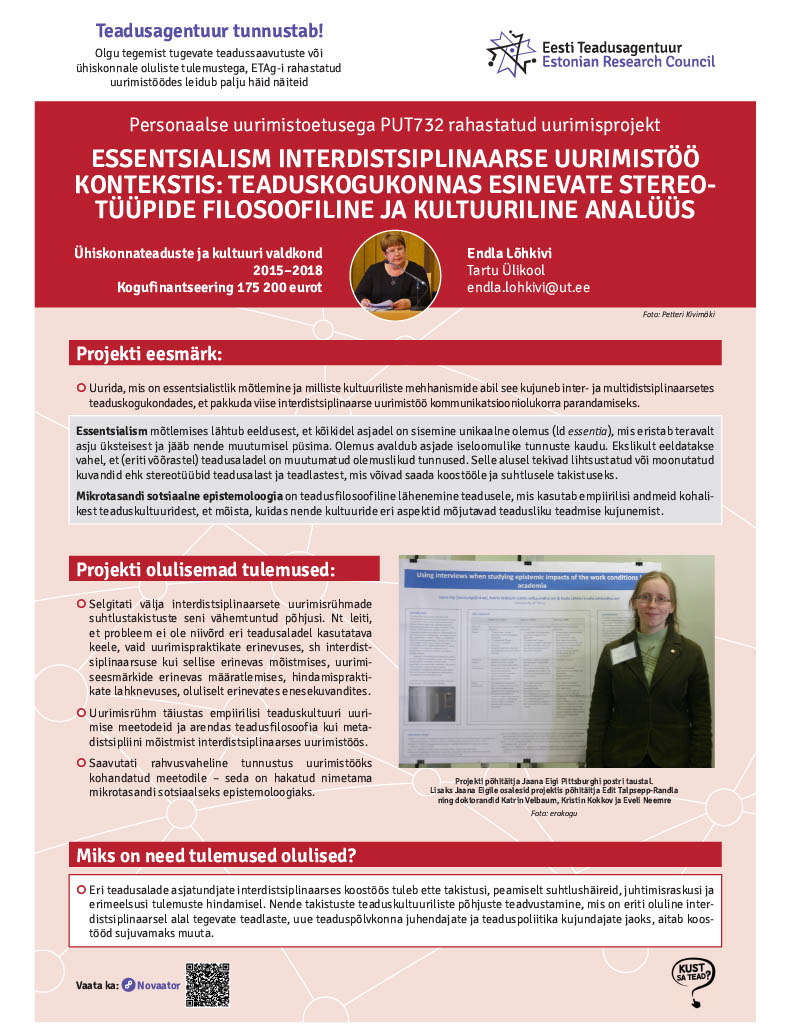Interdisciplinary research from philosophy of science perspective
Home
Welcome to the homepage of the philosophy of science research project “Philosophical analysis of interdisciplinary research practices”(Estonian Research Council grant PRG462)!
Why interdisciplinarity?
Interdisciplinarity is commonly seen as a contemporary phenomenon that serves to tear down and overcome fossilized disciplinary borders that have hampered scientific and technological progress. But what is it about such borders that over the course of the history of science and technology that hampers such progress? Is it the presence of some predefined, pregiven structures? If so, what makes them an obstacle in terms of collaboration between scientists from different disciplines? What are scientific disciplines in the first place? Our research group seeks answers to these and other related questions; questions that until now have gained little attention from philosophers of science.
Disciplinary borders and research
When studying the history of academic organizations it quickly becomes clear that there has never been any stable structure within science. The borders and methods of different scientific fields have been in constant flux and change. Ancient science comprised the predecessors of scientific fields as we know them today, however, they were not boxed as separate disciplines. Modern scientific disciplines were born and took shape in different contexts – churches and monasteries, universities or their antecedents/precursors, pharmacies, smithies, artisan workshops. The modern tradition of experimentation began in the 16th century in associations and unions (seltsides ja ühingutes), whereas universities specialized in the interpretation of classical texts. With the invention of printing, the nature of activities taking place in academic institutions changed, too. Instead of copying and transcribing texts, the focus now shifts to collecting, comparing and grouping texts. It is precisely in the context of this task of grouping that the disciplinary identity of written texts attains relevance. This not only pertains to texts – other kinds of collected materials, samples, exemplars also need systematization, labeling and preserving. The borders of contemporary scientific disciplines thus begin to take shape. At first, these borders are drawn along superficial similarities and dissimilarities; they soon need to be redrawn, as certain theoretical inconsistencies in them become apparent.
For a long time, different scientific disciplines were thought to relate to one another hierarchically. There were different kinds of these hierarchies. For instance, according to one, philosophy was the most basic qua the lowest of the disciplines  from which more advanced forms of knowledge emerged, such as medicine, law, and theology. According to an alternative representation, philosophy, along with theology, ethics, and logic, is on the contrary, the highest of the disciplines, one that integrates all others. Also today we use two parallel systems for classifying scientific disciplines: the Frascati Manual and the Common European Research Classification Scheme (CERCS).
from which more advanced forms of knowledge emerged, such as medicine, law, and theology. According to an alternative representation, philosophy, along with theology, ethics, and logic, is on the contrary, the highest of the disciplines, one that integrates all others. Also today we use two parallel systems for classifying scientific disciplines: the Frascati Manual and the Common European Research Classification Scheme (CERCS).
The changing borders between scientific disciplines are a matter of bureaucratic convention. The problems that scientists try to tackle don’t ask of disciplinary borders. Although some of these problems are indeed defined by the concepts and theories of some specific discipline, often they are not. From the very beginning, researchers from different disciplines have worked together. However, such interdisciplinary collaboration is not easy. Research practices within different disciplines vary significantly, e.g. with regard to the language used, the measurement and calculation methods, etc. This brings about philosophically interesting questions: how do scientists from different fields who engage in interdisciplinary research understand the nature of scientific problems? How do they proceed when attempting to solve these problems? Do they create a shared method and a conceptual framework which suits everyone but is not specific to any individual discipline? How do they communicate and explain their research to audiences outside the laboratory, outside institutional science?
Our research team and methods
Our research group investigates these kinds of questions. We are a group of philosophers of science from different disciplinary backgrounds. We share an interest in science as a research practice which we understand as a historical cultural phenomenon, as a practice constituted by method, logic, language and tacit experiences. We call our philosophical perspective on science “practical realism” as defined by Rein Vihalemm, a philosopher of science who has greatly influenced our approach to science both as a teacher and colleague. Our method can be described as a type of micro-social epistemology that has been adjusted for the study of science culture. Our aim is to understand how scientists develop research methods within interdisciplinary research contexts; which factors enhance the advancement of interdisciplinarity and which factors constrain it; what is the role of researchers’ epistemic identity in the context of interdisciplinary research ; what follows from all this for science evaluation?
We study the dynamics of disciplinary and interdisciplinary science from the historical perspective but also through examples from contemporary biological and social sciences, chemistry, law, engineering sciences, animal studies, archeology, humanities, and IT related fields.
Contact us!
This webpage provides information about our group, publications, past and upcoming events and activities, references to topical literature and other resources. If you have questions, feel free to contact us by writing to interdisphil@ut.ee. We welcome and are grateful for any feedback.
Wishing you a good read,
Endla Lõhkivi, PI



